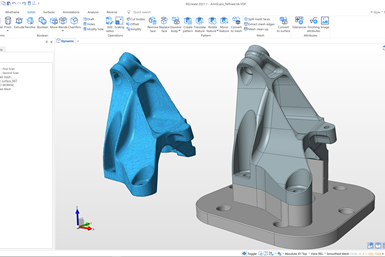Hexagon Recreate Streamlines Reverse Engineering Processes
Hexagon Manufacturing Intelligence’s Recreate provides a single digital working environment for reverse engineering, from scanning to 3D CAD modeling.
Share





Hwacheon Machinery America, Inc.
Featured Content
View More




Hexagon Manufacturing Intelligence has launched Recreate, a software solution the company designed to simplify reverse engineering from metrology scan to CAD model.
Reverse engineering processes are routinely employed throughout manufacturing and maintenance processes — but often require complex digital workflows to account for incompatible data types and technologies. These workflows are prone to errors, and so require significant expertise and access to multiple tools, requirements that create bottlenecks in many organizations.
Recreate removes complexity by providing a single working environment from scan to CAD model. Its CAD tool suite enables users to import models and drawings from any point-cloud data, or create their own complete CAD models and 2D engineering drawings. Recreate’s analysis tools also enable manufacturing professionals to validate 3D models before exporting as CAD or STL for computer aided manufacturing (CAM) or additive manufacturing processes.
While designed to be interoperable and slot into a customer’s existing processes, the solution offers additional benefits to customers that use other Hexagon technologies. Sites that use Hexagon’s portable arms for inspection can reduce training needs by enabling operators to read inspection data directly from the device, allowing them to reverse engineer using a single solution. Hexagon also tested Recreate with its production software tools for planning, optimizing and programming machining processes.
“We believe that by making reverse engineering software versatile and easy-to-use, Recreate gives design, production and inspection teams greater confidence in their reverse engineering processes,” says Ken Woodbine, Recreate product manager. “With the laser scanning technologies available today, there’s no reason why most use cases can’t be addressed by anyone who needs them, provided they have access to the data and tools required — be that ensuring a precise fit for replacement components, repairing legacy parts or updating design files with adjusted geometries following prototype creation or production optimizations.”
Related Content
-
Can ChatGPT Create Usable G-Code Programs?
Since its debut in late 2022, ChatGPT has been used in many situations, from writing stories to writing code, including G-code. But is it useful to shops? We asked a CAM expert for his thoughts.
-
ERP Provides Smooth Pathway to Data Security
With the CMMC data security standards looming, machine shops serving the defense industry can turn to ERP to keep business moving.
-
Orthopedic Event Discusses Manufacturing Strategies
At the seminar, representatives from multiple companies discussed strategies for making orthopedic devices accurately and efficiently.






































